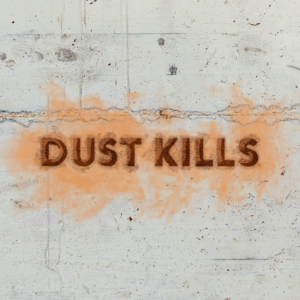
A snapshot of good and bad practices of how workers’ exposure to dust is being managed and controlled on construction sites across Great Britain has been revealed.
As part of its Business Plan, the Health and Safety Executive (HSE) carried out more than 1,000 inspections between May and July, focusing on what businesses and workers were doing to prevent or adequately control the risks from construction dust.
HSE’s Dust Kills campaign supported the site inspections, which raised awareness of the inspections, provide helpful advice, information, and links to guidance, for employers and workers. Almost two million connections were made to the campaign via the social media channels alongside extensive stakeholder and press coverage.
The inspections by Britain’s national regulator for workplace health and safety revealed examples of good practice on sites and within companies. These included; the use of motorised water suppression alongside face fit tested FFP3 respiratory protective equipment (RPE) to reduce exposure to silicosis and lung cancer causing respirable crystalline silica (RCS); air fed hoods (or powered air respirators) being used when using high powered cutting saws during carpentry to prevent exposure to asthma causing wood dust; and the inclusion of details of HSE’s campaign within company health, safety & environmental newsletters to raise awareness of the effects of dust exposure and the importance of effective control measures to improve the long-term health of construction workers.
However, HSE’s inspectors also found many examples of poor practice, including no on-tool extraction in place on high powered cutting saws that generate silica and wood dust, along with poorly maintained extraction equipment such as hoses and units making it ineffective; suitable RPE not being made available on site for workers to use or making it available but not ensuring it is used; and the health of workers not being considered when carrying out the simplest of tasks such as sweeping up indoors, which requires damping down to control the dust generated and the provision of suitable face-fit tested RPE.
A key area of concern for the regulator is that inspectors are still finding sites where the hierarchy of controls are simply not considered at all; where no effective design or planning has taken place to eliminate risks from dust, such as considering the use of pre-cut materials, and nothing being in place to minimise the risks by use of suitable control measures, such as water suppression and on-tool extraction and the use of RPE.
HSE’s Acting Head of Construction Division Mike Thomas said: “Regularly breathing in the dust generated by many construction activities can cause diseases like lung cancer, asthma, chronic obstructive pulmonary disease (COPD) and silicosis.
“Every year we see construction workers die from these diseases caused or made worse by their work because the necessary precautions required to protect their long-term lung health have not been taken by employers and workers themselves.
“The 1,000 plus inspections completed took place across a range of construction sites to check the action businesses are taking to ensure their workers’ health is being protected. Some of the examples of good practice found on sites during the campaign are really pleasing. But, as can be seen by some of the poor practices found by our inspectors, where planning around the risks of dust and controls to prevent exposure are not even considered, it shows there is still plenty of room for improvement.
“A full evaluation of the inspection data is underway, and we will release more information in due course.”
The early findings come at the start of UK Construction Week that runs from 3-5 October in Birmingham.
The law requires employers to prevent the ill health of their workers as far as reasonably practicable, which includes prevention or adequate control of workers’ exposure to construction dust.
Ideally, elimination of the risk of exposure to dust for workers should be achieved by good design and planning. Where this is not possible, measures should be put in place to control dust and provide workers with appropriately fitted RPE. Employees should also play their part by taking responsibility for wearing and maintaining RPE provided.
Notes to Editors
- The Health and Safety Executive (HSE) is Britain’s national regulator for workplace health and safety. We prevent work-related death, injury and ill health through regulatory actions that range from influencing behaviours across whole industry sectors through to targeted interventions on individual businesses. These activities are supported by globally recognised scientific expertise.
- Further details of HSE’s Business Plan can be found: HSE annual business plan – HSE
- HSE partnered with construction and occupational health organisations to highlight the control measures required on site to prevent exposure to dust. The network of Dust Killspartners includes Construction Industry Advisory Committee (CONIAC) and Civil Engineering Contractors Association (CECA), Construction Leadership Council (CLC), Health in Construction Leadership Group (HCLG) and Construction Dust Partnership. For more information visit the Work Right campaign page.